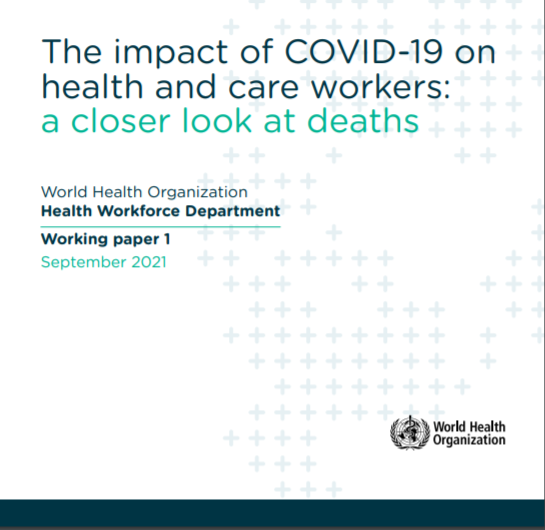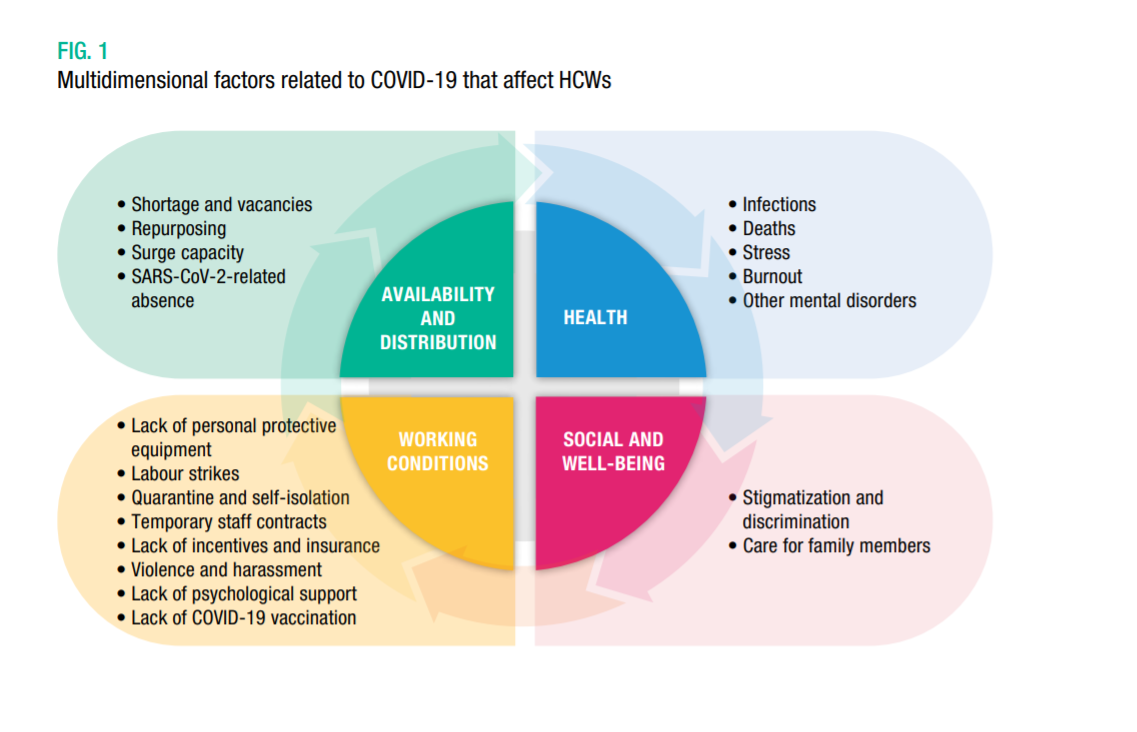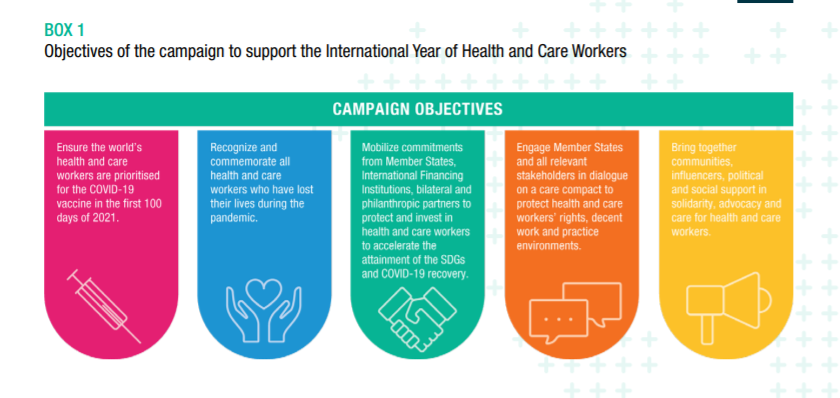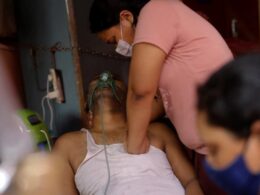Deaths of Health Care Workers (HCW) in Brazil are in the range of 10.000 to 13.000.
Joaquim Cardoso
The Health Strategist blog
October 21st, 2021
This is a one page summary based on the article on the second part of this article.
Key messages
- A new WHO working paper estimates that between 80 000 to 180 000 health and care workers could have died from COVID-19 in the period between January 2020 to May 2021, converging to a medium scenario of 115 500 deaths.
- The organizations are concerned that large numbers of health and care workers have died from COVID-19, but also that an increasing proportion of the workforce are suffering from burnout, stress, anxiety and fatigue.
In a Joint Statement issued this week, WHO and partners are calling on all Member State governments and stakeholders
- To (1) strengthen the monitoring and reporting of COVID-19 infections, (2) ill-health and (3) deaths among health and care workers.
- They should also include disaggregation by age, gender and occupation as a standard procedure, to enable decision makers and scientists to identify and implement mitigation measures that will further reduce the risk of infections and ill-health.
- The Statement also urges political leaders and policy makers to do all within their power to make regulatory, policy and investment decisions that ensure the protection of health and care workers.
- It highlights the opportunity to align this with a forthcoming global health and care worker compact and the International Labour Organization’s call for a human-centered recovery from the COVID-19 crisis.
- Finally, the partners call upon leaders and policy makers to ensure equitable access to vaccines so that health and care workers are prioritized in the uptake of COVID-19 vaccinations.
ORIGINAL PUBLICATION

WHO
21 October 2021
WHO and partners call for action to better protect health and care workers from COVID-19
The World Health Organization and partners have issued an urgent call for concrete action to better protect health and care workers worldwide from COVID-19 and other health issues.
The organizations are concerned that large numbers of health and care workers have died from COVID-19, but also that an increasing proportion of the workforce are suffering from burnout, stress, anxiety and fatigue.
The organizations are concerned that large numbers of health and care workers have died from COVID-19, but also that an increasing proportion of the workforce are suffering from burnout, stress, anxiety and fatigue.
In a Joint Statement issued this week, WHO and partners are calling on all Member State governments and stakeholders To (1) strengthen the monitoring and reporting of COVID-19 infections, (2) ill-health and (3) deaths among health and care workers.
They should also include disaggregation by age, gender and occupation as a standard procedure, to enable decision makers and scientists to identify and implement mitigation measures that will further reduce the risk of infections and ill-health.
The Statement also urges political leaders and policy makers to do all within their power to make regulatory, policy and investment decisions that ensure the protection of health and care workers.
It highlights the opportunity to align this with a forthcoming global health and care worker compact and the International Labour Organization’s call for a human-centered recovery from the COVID-19 crisis.
Finally, the partners call upon leaders and policy makers to ensure equitable access to vaccines so that health and care workers are prioritized in the uptake of COVID-19 vaccinations.
Available data from 119 countries suggest that by September 2021, 2 in 5 health and care workers were fully vaccinated on average, with considerable difference across regions and economic groupings.
Less than 1 in 10 have been fully vaccinated in the African and Western Pacific regions while 22 mostly high-income countries reported that above 80% of their health and care workers are fully vaccinated. A few large high-income countries have not yet reported data to WHO.
“ We have a moral obligation to protect all health and care workers, ensure their rights and provide them with decent work in a safe and enabling practice environment. This must include access to vaccines”,
said Jim Campbell, Director of the WHO Health Workforce Department. “
Beyond vaccines , economic recovery and all new investments in emergency preparedness and response must prioritize the education and employment of health and care workers, linking to the UN Secretary-General’s Global Accelerator for Jobs and Social Protection,” he added.
A new WHO working paper estimates that between 80 000 to 180 000 health and care workers could have died from COVID-19 in the period between January 2020 to May 2021, converging to a medium scenario of 115 500 deaths. These estimates are derived from the 3.45 million COVID-19 related deaths reported to WHO as at May 2021; a number by itself considered to be much lower than the real death toll (60% or more than what is reported to WHO).
“ This WHO working paper provides a stark number to stimulate greater action; we cannot afford to lose more health and care workers and our world will not recover from the pandemic without long-term, sustainable investments in the health workforce,” said Catherine Duggan, Chief Executive Officer of the International Pharmaceutical Federation and one of several members of the World Health Professions Alliance allied with the Joint Statement.
WHO is currently leading efforts to develop a global health and care worker compact, based on existing legal instruments, conventions and resolutions. The compact aims to provide Member States, stakeholders and institutions with comprehensive guidance on their existing obligations to protect health and care workers, safeguard their rights, and to promote and ensure decent work, free from gender, racial and all other forms of discrimination. The guidance will be presented to the 75 thWorld Health Assembly in May 2022.
Names cited:
Jim Campbell, Director of the WHO Health Workforce Department. “
Originally published at https://www.who.int on October 21, 2021.
TAGS: Resilient Health Systems; Health Care Workers (HCW); Mental Health;
ORIGINAL PUBLICATION
Key messages
- Between January 2020 and May 2021, surveillance data reported to WHO showed 3.45 million deaths due to COVID-19. Of these only 6643 deaths were identified as being in health and care workers (HCWs), but this figure significantly under-reports the burden of mortality world-wide in this group.
- From different analytical approaches, this working paper attempts to estimate the global number of deaths in HCWs due to COVID-19.
- Based on the International Labour Organization’s estimated number of 135 million HCWs employed in human health and social activities and WHO’s surveillance data on all deaths reported to be due to COVID-19, mixed analytical approaches present a range between 80 000 to 180 000 deaths globally with a central population-based estimate of 115 500 deaths.
- These figures, however, largely derive from the 3.45 million COVID-19-related deaths reported to WHO, a number that by itself is proving to be much lower than the actual death toll (60% or more than reported to WHO).
- High-quality recording and reporting of infections and deaths among HCWs are fundamental measures to enable appropriate protective steps to be instigated and to support calls for significant investments in integrating occupational data in death certification and surveillance reporting.
- In view of the mounting evidence that the number of deaths due to COVID-19 among HCWs is much greater than officially reported, the need for protection through vaccination cannot be overstated.
- In countries where vaccination rates of HCWs remain low, tailored communication strategies must be designed and actively pursued to increase uptake and avert vaccination hesitancy
Background
On 30 January 2020, the Director-General of the World Health Organization (WHO) declared the outbreak of disease due to a novel coronavirus a public health emergency of international concern: WHO’s highest level of alarm (1). For health and care workers (HCWs) around the world the pandemic caused a heightened risk of occupational exposure to a new fastspreading disease and created the need to adapt roles and responsibilities for a wide range of tasks and professional settings (2,3).
Intense global mobilization of public health and social measures in health facilities and communities followed, alongside the introduction of clinical protocols and individual risk assessment in hospital settings (4). The pandemic resulted in many infections and deaths among HCWs and their households (5); the consequences continue to be measured by a diverse stream of anecdotal evidence and variable quality standards (6–9).
Undoubtedly, the health and care sector is one of the most severely hit by the pandemic as those employed or contracted in it face multiple hazards that affect their physical, mental and social well-being. HCWs have been documented to have a higher risk of infection with SARS-CoV-2 than the general population (10).
Throughout 2020, the WHO Secretariat elaborated a framework to support the standardized measurement and reporting of the multidimensional impact of the pandemic on HCWs, including
- infection,
- death and mental health disorders
- but also the consequences of labour strikes and protests (Fig. 1) (11).

Concerns over the broader impact of the pandemic on HCWs and their crucial role at the forefront of the response were recognized by the Seventy-third World Health Assembly at its resumed session in November 2020 with the designation in decision WHA73(30) of 2021 as the International Year of Health and Care Workers (12).
Shortly thereafter WHO launched a global campaign to support the International Year (13).
The objectives of the campaign (Box 1) include a focus on protecting HCWs from harm.
- The campaign prioritizes vaccination of HCWs against COVID-19, calls for the measuring of all deaths of HCWs from COVID-19,
- and emphasized the need for global governance to agree a compact that upholds the principle of the duty of care.
Only by measuring the numbers of vaccinations, infections and deaths specifically by occupation for HCWs can national authorities implement appropriate policy measures and responses to reduce the risks of infection and death to HCWs.

As at the time of writing this working paper (7 July 2021), reports to WHO from more than 100 Member States indicate the uptake of COVID-19 vaccination by HCWs, although with considerable differences occurring across different WHO regions (14).

The impact of COVID-19 on health and care workers: a closer look at deaths
When autocomplete results are available use up and down arrows to review and enter to select.www.who.int












